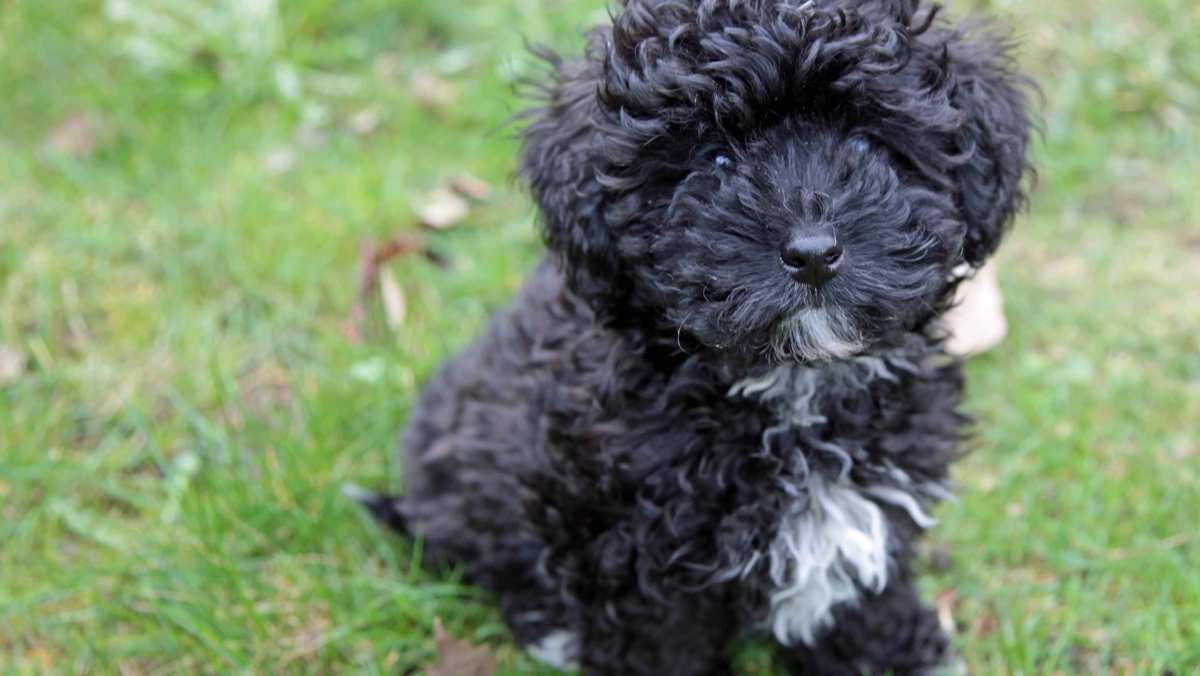Havapoo Breed Details
Below are the details and specs for the Havapoo breed:

The Havapoo, also known as the Poovanese, is a hybrid dog which is bred by crossing a Poodle with a Havanese. As a hybrid the Havapoo will inherit the physical and behavioral traits of both the Poodle and Havanese breeds. Not all individuals will inherit the same characteristics (even if from the same litter). It is recommended to familiarize yourself with both the Havanese and the Poodle if you are planning on adopting a Havapoo as the breed can have more characteristics of one parent breed than the other.
This breed is known for being sociable, intelligent, and low maintenance. It is a very small sized breed with a long, curly, hypoallergenic coat and dark button eyes. These dogs will require a minimal amount of grooming and little effort when it comes to exercise--they can expend a lot of energy running around indoors. Havapoos are easy to train and very willing to please their owner. These dogs are wonderful with people of all ages. It is a very popular breed among elderly couples and families with small children.
Below are the details and specs for the Havapoo breed:
The Havapoo is a toy sized breed. An adult Havapoo will weigh between 7-15 pounds and stand 9-12 inches tall from ground to shoulder. Their size makes them rather fragile, however they are great for apartment living and owners without the means to care for a large dog.
These dogs are typically quite friendly and playful. They are known to be gentle with children and should get along with other pets if properly socialized and trained. Due to their small size and their benign attitude, you can leave Havapoos alone with children without concern.
This breed is easy to take care of, very low maintenance. Their non-shedding coat should be brushed once or twice a week to remove dead hairs, and their exercise needs can be met with indoor playtime or a short walk.
The Havapoo is a fairly new dog breed and because of this the breed does not have a very detailed history. It is likely that the Havapoo was first intentionally bred in the past few decades as the popularity of designer hybrid dogs increased. This breed is recognized by the ACHC (American Canine Hybrid Club) under the name Poovanese.
As a crossbreed, the Havapoo will inherit physical traits from both parent breeds. Not all Havapoos will inherit the same traits which means some Havapoos may have more Havanese characteristics, others may have more Poodle characteristics, and some may show a mix of both parent breeds.
The Havapoo's coat is hypoallergenic, long, and curly or wavy like the Poodle's. Their small frame is rectangular and somewhat squat due to their short legs. Their head is small and often covered in long hair, giving them a sort of old, whiskered look. Their ears are soft and floppy, falling down towards the cheek, and their eyes are round and dark.
The temperament of the Havapoo is dependent on the behavioral traits inherited from its parents. Some Havapoos will inherit traits from the Poodle, others the Havanese, and some will have a mix of behaviors inherited from both parent breeds.
These dogs are known to be exceptionally friendly and playful. They will never fail to greet their owner(s) with enthusiasm and joy. They are intelligent dogs, and very willing to please, making them easy to train and teach tricks. Positive reinforcement works very well--Havapoos are very sensitive to tone of voice. They will get along well with people of all ages and should not have a problem with other pets, though socialization from a young age is recommended. The more people this dog meets at a young age, the more accustomed it will be to new faces. Otherwise this dog is apt to bark at strangers, but will not present any sort of intimidating threat. All of these qualities make for a fantastic family dog or an affectionate companion.
You can expect the Havapoo to be a low maintenance dog breed. They will need a small amount of brushing, and their exercise load is light.
The Havapoo has a hypoallergenic non-shedding coat that won't require much maintenance. Brushing once or twice a week should be enough. Bathing should be done once every month or two to ward off infections.
The Havapoo is a fairly energetic breed, though it is active indoors and will not require a great deal of outdoor exercise. A short daily walk should be more than enough, and if a day needs to be skipped, the Havapoo will be fine with some indoor play.
The Havapoo can adapt to a wide variety of environments. They can call somewhere home whether it's an apartment or a large house. This breed is especially suitable for small locations due to its small size. If these dogs are kept in a more rural area, it is wise to keep them fenced in to keep them safe from predators and to minimize the risk of escape.
As a hybrid dog breed, the Havapoo will have more genetic diversity than most purebred breeds which helps with the breed's health and hardiness. There are no known hereditary issues with this breed. A Havapoo with a healthy diet and a proper amount of exercise will live between 10 and 13 years.
Below are the most common health issues associated with the breed:
Below are potential health concerns associated with Havapoos.